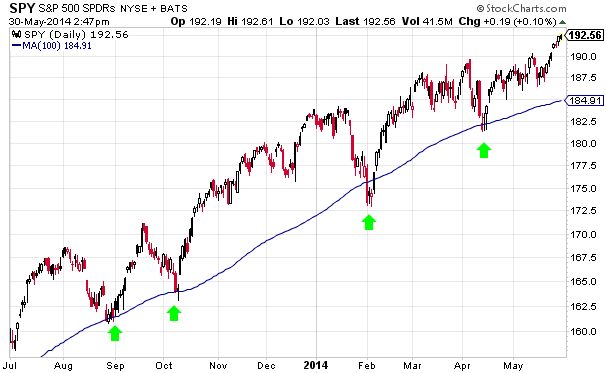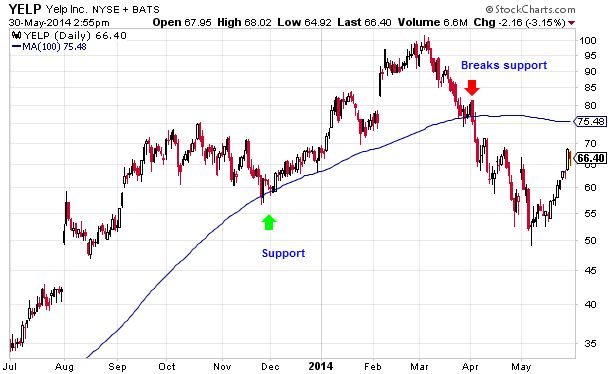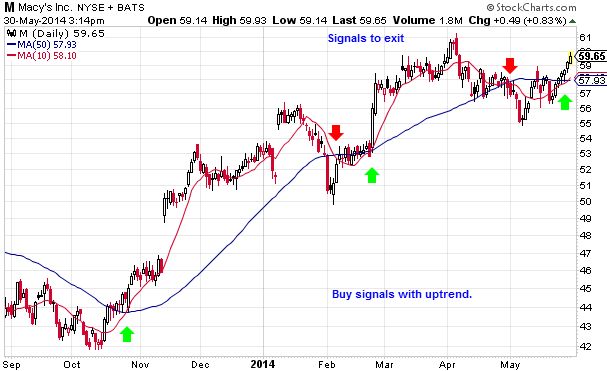3 Ways to Use Moving Averages in Your Trading
3 Ways to Use Moving Averages in Your Trading
A moving average (MA) is one of the simplest trading tools and can help new traders spot trends and potential reversals. Here’s an introduction to the moving average, as well as three ways to use it.
Moving Averages
The Simple Moving Average (SMA) is the most commonly used MA. It shows the average price over a number of periods.
A 15 period SMA will add up all the closing prices over the last 15 periods (whether these are 1-minute periods or 1-hour periods, etc) and then divide that number by 15 to produce an average. As each new period (price bar) completes, the average is updated to only reflect the last 15 periods.
How many periods to use varies dramatically from trader to trader. Short-term traders especially will use different SMA period lengths. Longer-term traders will frequently use the 50,100 and 200 day moving averages.
Moving Average Uses – Support and Resistance
Moving averages provide areas of potential support or resistance during a trend. Isolate the moving average which is supporting the trend on pullbacks to find potential entry points.
Figure 1 shows how the 100-day SMA did a very good job at providing support to the rise in the S&P 500 ETF (SPY).
Figure 1. S&P 500 SPDR with 100-Day SMA

The first two times the price “tested” the MA just let us know that the MA is providing support. When the price finds support at the MA a third and fourth time, then those are potential trade areas. Traders could look to buy when the price pulls back to the MA, preferably with the aid of other indicators or strategies.
With this strategy you’ll need to implement your own risk control and determine when the ideal to get out of the trade once you are in it.
Moving Average Uses – Price Crossovers
If a moving average can provide support or resistance then when the price crosses over the MA it can indicate a trend reversal. Figure 2 shows this in action. The price respects the SMA during the uptrend, but then breaks below it the next time. This indicated a larger reversal was underway, and potentially a full-fledged trend reversal (which is what occurred).
Figure 2. Yelp Daily Chart with 100-Day SMA

The downside of this strategy is “false signals.” This is when the price crosses a SMA, indicating a reversal which doesn’t materialize. In other words, the price will continues whip back and across the SMA causing multiple false signals and losing trades.
Once again, risk management and finding a way to profitably exit is up the trader. This simple approach only provides an entry area, or possibly confirmation of a reversal when trading other methods.
Moving Average Uses – MA Crossovers
Having two moving averages of different lengths on your chart can provide additional trade signals.
Longer-term traders will commonly use a 200-day and 50-day. Day traders may use a 50-period and 15 or 10-period (likely minutes).
When the shorter MA crosses above the longer MA it shows buying is picking up and presents a potential buying opportunity. When the short MA crosses below the longer MA it shows selling is picking up and presents a potential selling/shorting opportunity.
Figure 3. Macy’s with 50 and 10-Period SMA

Similar to the price-crossover strategy, it is possible to get multiple false signals when the MAs crisscross back and forth.
To help avoid this, only take trades in the direction of the overall trend. In figure 3 long are taken when the short SMA (red) crosses above the longer SMA (blue). Exit the trade when the shorter SMA crosses back below the longer SMA.
If the trend were down, you’d only take short trade signals when the short SMA crosses below the longer SMA.
You’ll still need to define your risk on each trade.
The Final Word
The SMA is a straight forward tool that is applied to the chart and shows the average price over a specific period of time. It can provide support and resistance, although other indicators and analysis should be used to determine if the SMA area provides a good entry point. It can also be used for price and MA crossovers. Both of these are prone to false signals, which is when the price or MAs crisscross each other resulting in a number of losing trades. Using trend analysis can help in this regard. MAs are a tool to help with trading, but aren’t a complete strategy. You’ll need to incorporate risk controls and determine how you will exit these trades in order to form a more complete and tradable MA strategy.